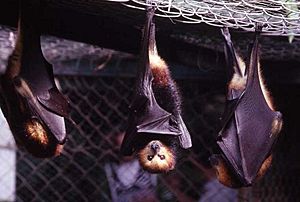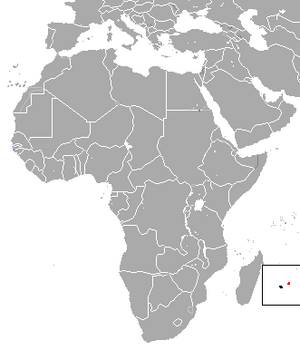Mauritian flying fox facts for kids
Quick facts for kids Mauritian flying fox |
|
|---|---|
 |
|
| Conservation status | |
| Scientific classification | |
| Genus: |
Pteropus
|
| Species: |
niger
|
 |
|
| Mauritian flying fox range (red — extant, black — extinct) |
|
| Synonyms | |
|
Vespertilio vampirus niger Kerr, 1792 |
|
The Mauritian flying fox (Pteropus niger) is also known as the Greater Mascarene flying fox or Mauritius fruit bat. It is a type of very large bat. This special bat lives only on the islands of Mauritius and La Réunion. When an animal lives only in one specific place, we say it is endemic to that area. An older name for this bat was Vespertilio niger.
Contents
What is a Mauritian Flying Fox?
The Mauritian flying fox is a kind of megabat. Megabats are the largest bats in the world. They are also called "fruit bats" because they mostly eat fruit. Unlike many smaller bats, flying foxes do not use echolocation (sending out sounds to find things). Instead, they use their excellent eyesight and sense of smell to find food.
Physical Features of the Bat
Mauritian flying foxes are quite big. They can have a wingspan of about 80 centimeters (31 inches). This is roughly the length of a baseball bat! Their bodies are covered in dark, reddish-brown fur. They have a fox-like face, which is why they are called "flying foxes."
Where Do These Bats Live?
These bats are native to the islands of Mauritius and La Réunion. These islands are in the Indian Ocean, off the coast of Africa. They prefer to live in forests, especially those with lots of fruit trees. They roost (rest) in large groups in trees during the day. At night, they fly out to find food.
What Do Mauritian Flying Foxes Eat?
Mauritian flying foxes are herbivores, meaning they only eat plants. Their diet mainly consists of fruit, nectar, and pollen. They play a very important role in their ecosystem. As they fly from tree to tree, they help to pollinate flowers and spread seeds. This helps new plants grow and keeps the forest healthy.
Favorite Foods
They enjoy a variety of fruits found on the islands. They also drink nectar from flowers, which gives them energy. By eating fruit, they help many native trees reproduce.
Life Cycle and Reproduction
Mauritian flying foxes usually have one baby at a time. The baby bat is called a pup. Pups are born without fur and are very small. The mother takes care of her pup, carrying it with her as she flies.
Growing Up
Pups cling to their mother's belly for the first few weeks. They drink their mother's milk until they are old enough to start eating fruit. As they grow, they learn to fly and find food on their own. They become independent after a few months.
Why Are They Endangered?
The Mauritian flying fox is listed as an endangered species. This means their numbers are very low, and they are at risk of disappearing forever. Several things threaten these bats.
Threats to Their Survival
- Habitat Loss: Forests where they live are being cut down for farming or building. This leaves the bats with fewer places to live and find food.
- Cyclones: Strong tropical storms (cyclones) can destroy their habitats and kill many bats.
- Hunting: Sadly, some people hunt these bats for food. This is illegal but still happens.
- Conflict with Farmers: Sometimes, bats eat fruit from farms, which makes farmers upset. This can lead to efforts to reduce bat numbers.
Conservation Efforts
Many people and organizations are working to protect the Mauritian flying fox. These efforts include:
- Protecting and restoring their forest habitats.
- Educating people about the importance of bats.
- Working with farmers to find ways for bats and farms to coexist.
- Monitoring their populations to understand how many bats are left.
By understanding and protecting these unique animals, we can help ensure the Mauritian flying fox continues to fly over the islands for many years to come.
See also
 In Spanish: Zorro volador negro de Mauricio para niños
In Spanish: Zorro volador negro de Mauricio para niños


